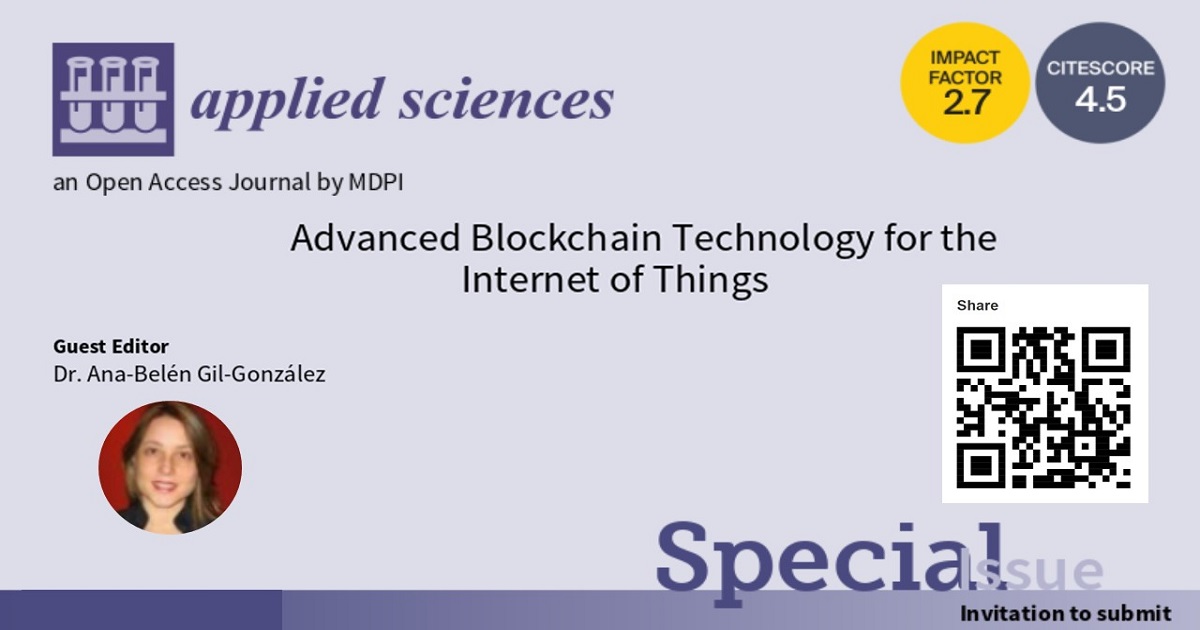Advanced Blockchain Technology for the Internet of Things
A special issue of Applied Sciences (ISSN 2076-3417). This special issue belongs to the section "Computing and Artificial Intelligence".
Deadline for manuscript submissions: 20 September 2024 | Viewed by 842

Special Issue Editor
Interests: applied artificial Intelligence; machine learning; intelligent control engineering; renewable energy engineering; system optimization; smart city; human–computer interaction
Special Issues, Collections and Topics in MDPI journals
Special Issue Information
Dear Colleagues,
The realm of Computer Engineering is witnessing a profound transformation as the Internet of Things (IoT) revolutionizes traditional industries, turning them into intelligent sectors powered by data-centric decision making. However, the inherent attributes of the IoT pose several complex challenges, including decentralization, deficient interoperability, and vulnerabilities related to privacy and security. Blockchain inherently complements the IoT by presenting enhanced interoperability, privacy, security, reliability, and scalability.
This Special Issue on 'Advanced Blockchain Technology for the Internet of Things' examines the novel paradigm that integrates blockchain with the IoT, resulting in a convergence termed Blockchain of Things (BCoT).
The progression from conventional computer-aided industries to smart industries driven by data-driven choices has been facilitated by the IoT. In this paradigm shift, the IoT assumes a pivotal role by establishing connections between the physical industrial environment and the computational realm, effectively giving rise to a Cyber-Physical System (CPS). IoT applications span diverse industrial domains, including manufacturing, logistics, food industries, energy grids, healthcare data management, and utilities. The primary objectives of the IoT are to enhance operational efficiency, elevate production throughput, minimize machine downtime, and elevate product quality. Notably, the characteristics of the IoT include decentralized systems, a myriad of devices and systems, diverse datasets, and intricate network configurations. These features collectively contribute to challenges, such as system heterogeneity, inadequate interoperability, resource limitations in devices, and susceptibility to privacy and security. Blockchain technology has emerged as a viable solution for addressing these issues. The IoT integrated with blockchain utilizes a cryptographically secure digital ledger to authenticate, store, and share data generated by interconnected devices. This fusion ensures reliable data storage while preventing falsification, corruption, or tampering with data generated by the IoT to enhance value chain transparency.
The symbiotic relationship between the Internet of Things (IoT) and blockchain technology is ushering in a paradigm shift in communication and interaction. This collaboration leverages a decentralized approach, transparency, traceability, reliability, a tamper-proof nature, and automation bestowed by the blockchain.
Dr. Ana-Belén Gil-González
Guest Editor
Manuscript Submission Information
Manuscripts should be submitted online at www.mdpi.com by registering and logging in to this website. Once you are registered, click here to go to the submission form. Manuscripts can be submitted until the deadline. All submissions that pass pre-check are peer-reviewed. Accepted papers will be published continuously in the journal (as soon as accepted) and will be listed together on the special issue website. Research articles, review articles as well as short communications are invited. For planned papers, a title and short abstract (about 100 words) can be sent to the Editorial Office for announcement on this website.
Submitted manuscripts should not have been published previously, nor be under consideration for publication elsewhere (except conference proceedings papers). All manuscripts are thoroughly refereed through a single-blind peer-review process. A guide for authors and other relevant information for submission of manuscripts is available on the Instructions for Authors page. Applied Sciences is an international peer-reviewed open access semimonthly journal published by MDPI.
Please visit the Instructions for Authors page before submitting a manuscript. The Article Processing Charge (APC) for publication in this open access journal is 2400 CHF (Swiss Francs). Submitted papers should be well formatted and use good English. Authors may use MDPI's English editing service prior to publication or during author revisions.
Keywords
- IoT
- blockchain
- Blockchain of Things (BCoT)
- big data
- deep learning
- traceability
- optimization techniques
- reliability
- interoperability
- privacy and security
- smart industries
- industrial IoT (IIoT)





